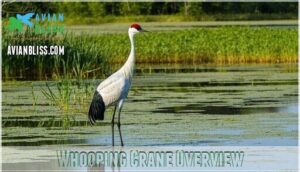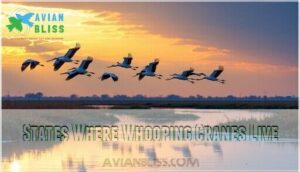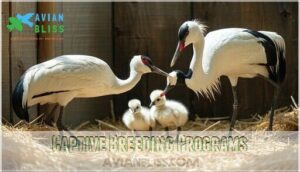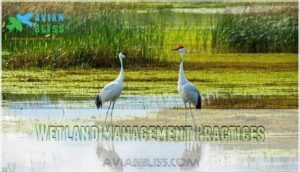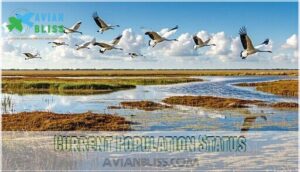This site is supported by our readers. We may earn a commission, at no cost to you, if you purchase through links.
 You’ll be amazed by the whooping crane, North America’s tallest bird standing five feet high with a seven-foot wingspan.
You’ll be amazed by the whooping crane, North America’s tallest bird standing five feet high with a seven-foot wingspan.
These magnificent white birds with distinctive red crowns nearly vanished in 1941 when only 15 remained, but conservation efforts have boosted their population to around 500.
They migrate 2,500 miles between Canada’s Wood Buffalo National Park and Texas’s Aransas National Wildlife Refuge each year, and their haunting calls carry two miles, making them unmistakable when you hear them.
Though still critically endangered, these graceful giants represent one of conservation’s greatest success stories, and understanding their migration patterns and preferred habitats reveals surprising secrets about where you’re most likely to spot them.
Table Of Contents
- Key Takeaways
- Whooping Crane Overview
- Geographic Distribution
- Conservation Efforts
- Threats to Survival
- Where to See Whooping Cranes
- Frequently Asked Questions (FAQs)
- How rare is the whooping crane?
- Where can I see whooping cranes in the US?
- Why did the whooping crane almost go extinct?
- What states have whooping cranes?
- Is it rare to see a whooping crane?
- Where can I see Whooping Cranes in the US?
- Why did the whooping crane go extinct?
- What states do Whooping Cranes live in?
- What unique courtship rituals do whooping cranes perform?
- How do whooping cranes communicate with each other?
- Conclusion
Key Takeaways
- You’ll witness one of conservation’s greatest success stories – whooping cranes bounced back from just 15 birds in 1941 to around 500 today through dedicated breeding programs and habitat protection.
- You can spot these five-foot-tall giants with seven-foot wingspans at specific locations: Aransas National Wildlife Refuge in Texas during winter, Nebraska’s Platte River during migration, and Wood Buffalo National Park in Canada for breeding.
- You’ll hear their haunting bugling calls carrying up to two miles across wetlands – these trumpeting sounds help crane families communicate during their epic 2,500-mile annual migration between Canada and Texas.
- You’re still looking at a critically endangered species facing ongoing threats from habitat loss, climate change, powerline collisions, and human development that could reverse decades of recovery progress.
Whooping Crane Overview
You’ll recognize America’s tallest bird by its striking white plumage, red crown, and impressive five-foot height that makes it impossible to miss in wetlands.
Standing five feet tall with snow-white feathers and that unmistakable crimson crown, these magnificent birds command attention wherever they roam.
This remarkable species has made one of conservation’s greatest comebacks, rising from just 15 birds in 1941 to over 500 today through dedicated rescue efforts.
Physical Characteristics
You’ll recognize the whooping crane (Grus americana) as North America’s tallest bird, standing five feet with a seven-foot wingspan.
Adult plumage displays snowy white feathers with black wingtips and a crimson crown.
Juvenile features include cinnamon-brown coloring that transforms to white by their second spring.
This monomorphic species shows similar identifying traits between sexes, making size comparison your best distinguishing method.
Habitat
You’ll find whooping cranes in diverse wetland habitats across North America, from coastal salt marshes to freshwater prairie potholes.
These magnificent birds depend entirely on healthy wetlands for survival, making wetland habitat conservation critical to their recovery from near-extinction.
- Aransas refuge serves as their primary wintering ground along the Texas Gulf Coast
- Migration stopovers include Nebraska’s Platte River and other prairie wetlands
- Breeding territories span remote muskeg lakes in Canada’s Wood Buffalo National Park
- Habitat restoration projects focus on protecting shallow marshes and grasslands
- Climate impacts and habitat loss threaten these endangered species’ remaining sanctuaries
Diet
Whooping cranes adapt their omnivorous diet seasonally, switching from summer’s insects, frogs, and small mammals to winter’s blue crabs and clams.
These majestic birds demonstrate remarkable foraging behavior, with juveniles learning dietary adaptations from parents.
Prey availability shapes their food resources, making them opportunistic feeders who’ll snatch whatever nature serves up, illustrating their ability to adapt to available food resources.
Behavior
Graceful dancers of the wetlands, these majestic birds exhibit fascinating crane behavior through elaborate courtship rituals.
You’ll witness their famous courtship dance featuring synchronized leaping, wing-flapping, and head-bowing displays.
Their bugling vocalizations carry for miles, establishing territories and maintaining family bonds.
Social structure revolves around monogamous pairs and family units.
Foraging habits include methodical hunting in shallow waters, while their remarkable homing instinct guides them back to ancestral breeding grounds year after year.
They also play a role in ecosystem balance by controlling insect populations.
Conservation Status
Despite decades of dedicated conservation efforts, whooping cranes remain endangered today.
Population recovery from just 21 birds in the 1940s to over 800 demonstrates remarkable species recovery success through breeding programs, habitat restoration, and legal protections.
International cooperation between Canada and the U.S. continues supporting this conservation milestone, though challenges persist.
The Aransas-Wood Buffalo population is currently the only self-sustaining group.
Geographic Distribution
You’ll find whooping cranes across a much smaller range today than their ancestors roamed just centuries ago.
These majestic birds now follow specific migration corridors between their Canadian breeding grounds and Texas wintering sites, with critical stopover points scattered throughout the Great Plains, which is a critical aspect of their migration pattern.
Historical Vs. Current Range
Once stretching across vast prairies and wetlands, the whooping crane’s historical range has shrunk dramatically.
Today’s population occupies less than 5% of their original territory, confined mainly to protected refuges.
Past Habitats the Species Once Called Home:
- Prairie wetlands spanning 21 U.S. states from New Jersey to Utah
- Tallgrass meadows across the upper Midwest’s pothole region
- Coastal marshes along the entire Gulf Coast and Atlantic shores
- Riverine wetlands throughout interior Canada and Northwest Territories
- Undisturbed grasslands covering over 100,000 acres in Texas alone
Range reduction eliminated 90% of suitable habitat between 1850-1950.
Habitat fragmentation from agriculture and development forced population relocation to managed reserves.
While reintroduced populations exist in Wisconsin, Florida, and Louisiana, future expansion remains limited without large-scale wetland restoration across their former migration corridors.
Migration Routes
You’ll find these magnificent birds following ancient pathways that span over 2,500 miles.
Their journey connects Wood Buffalo National Park in Canada to Texas coastal marshes, with stopover habitats along Nebraska’s Platte River providing essential rest stops.
| Migration Aspect | Details |
|---|---|
| Route Length | 2,500+ miles one-way |
| Migration Timing | Spring: March-May, Fall: September-November |
| Route Evolution | Shifts with climate impacts and habitat changes |
| Genetic Diversity | Maintained through population mixing during travel |
Climate impacts have shifted their schedule by up to 22 days, affecting traditional migration patterns that migratory birds have followed for generations.
Preferred Habitat Types
Whooping cranes thrive in diverse wetland environments that provide essential resources year-round.
Their habitat preferences shift seasonally, requiring specific wetland composition for survival. Understanding nest box placement can further aid conservation efforts.
- Coastal marshes and estuaries – Primary wintering grounds at Aransas National Wildlife Refuge
- Northern muskeg wetlands – Remote nesting locations in Wood Buffalo National Park
- Prairie potholes and shallow lakes – Critical roosting sites during migration
- Agricultural fields and floodplains – Secondary foraging grounds throughout their range
States Where Whooping Cranes Live
You can spot these magnificent birds across several states during their annual journey.
The primary crane population winters along Texas coastal marshes, particularly at Aransas National Wildlife Refuge.
During migration, they stop in Nebraska along the Platte River before reaching Canadian breeding grounds.
Florida hosts a small non-migratory population, while Louisiana’s reintroduction program continues building numbers.
These Migration corridors span North America, making crane migration one of our continent’s most remarkable wildlife spectacles, with a journey that covers various states and habitats, including the Platte River and Texas coastal marshes, ultimately leading to their breeding grounds.
Conservation Efforts
You’ll discover how conservationists pulled the whooping crane back from the brink of extinction through dedicated breeding programs and habitat protection.
These remarkable efforts transformed a population of just 20 birds in the 1940s into today’s thriving community of over 800 cranes across North America.
Population Decline
By the 1940s, you’d witness one of nature’s most devastating collapses as the whooping crane population plummeted to just 20 birds.
Historical hunting and habitat reduction drove this majestic species to near extinction through:
- Unregulated hunting decimating flocks across their range
- Wetland conversion destroying critical breeding grounds
- Agricultural expansion eliminating stopover sites
- Ecological changes fragmenting migration corridors
This dramatic bird population decline sparked urgent bird conservation efforts that would eventually fuel an remarkable crane recovery story.
Captive Breeding Programs
Three decades of captive breeding programs have become conservation’s lifeline for whooping cranes.
These facilities maintain genetic diversity while producing birds for reintroduction success across multiple sites.
However, program limitations include hybridization risks with sandhill cranes and ethical considerations about crane recovery dependency.
Despite challenges, captive breeding remains essential for endangered species conservation efforts until wild populations achieve true sustainability.
Wetland Management Practices
Effective wetland management practices form the backbone of whooping crane conservation efforts, protecting critical habitat through strategic water regulation and invasive control measures.
These restoration projects focus on habitat enhancement while maintaining proper salinity management across breeding and wintering grounds.
Many initiatives require specialized products and services.
- Water Regulation: Controlling water levels in marshes guarantees ideal feeding depths for cranes while supporting blue crab populations
- Invasive Control: Removing invasive plant species like purple loosestrife preserves native vegetation that cranes depend on for food
- Habitat Enhancement: Creating shallow water areas and maintaining open spaces provides ideal foraging conditions for avian wildlife
- Salinity Management: Monitoring salt levels in coastal marshes prevents habitat degradation that threatens wintering crane populations
- Restoration Projects: Converting former agricultural land back to wetlands expands available habitat along migration corridors
Current Population Status
Today’s whooping crane population tells a remarkable bird conservation success story, with approximately 826 wild individuals representing incredible population growth from just 15 birds in the 1940s.
This endangered species recovery demonstrates breeding success despite ongoing reintroduction challenges, while genetic diversity management and future projections suggest continued hope for the Grulla Trompetera’s survival.
Threats to Survival
Despite conservation successes, whooping cranes still face serious threats that could reverse their recovery progress.
You’ll find that habitat loss, climate change, and human activities continue to challenge these magnificent birds’ survival in the wild, which is a critical aspect of their recovery.
Habitat Loss and Degradation
You’ll face significant challenges when whooping cranes lose their homes to wetland conversion and development.
Salt marsh encroachment from rising seas shrinks critical wintering areas, while reduced inflows from damming and diversions degrade feeding grounds.
Ecological changes from agricultural expansion eliminate stopover sites along migration routes, making habitat loss the primary threat to endangered species recovery despite ongoing bird conservation efforts protecting remaining wetlands.
Climate Change
Climate change disrupts whooping cranes through multiple pathways that threaten their recovery.
Rising temperatures trigger earlier migration shifts, reducing chick survival rates when food sources aren’t synchronized with arrival timing.
Key climate threats include:
- Migration Shifts – Spring migration now occurs 8 days earlier since 1980
- Habitat Impacts – Wetland coverage dropped 40% from persistent drought conditions
- Drought Effects – Water depth declines force early migration, lowering recruitment 25%
- Salinization Threat – Reduced freshwater inflows increase salt levels in wintering marshes
- Temperature Changes – Heat waves double nest abandonment rates, affecting wildlife protection
These climate change impacts challenge bird conservation efforts across critical bird habitat areas during bird migration periods.
Hunting and Illegal Activity
Despite federal protection under the Endangered Species Act, poaching threats continue plaguing whooping cranes during migration.
Illegal trade and accidental shootings account for nearly 10% of annual deaths, with enforcement challenges in rural areas where hunters mistake cranes for legal game.
Wildlife protection efforts include $10,000 rewards for information leading to prosecutions of these devastating bird conservation challenges.
Habitat loss further exacerbates these issues, and urban development poses additional risks to the whooping crane population.
Contamination Risks
Chemical contamination poses serious threats to whooping crane populations through multiple pathways.
Pesticide exposure from agricultural runoff causes developmental deformities in chicks, while heavy metals like mercury and lead accumulate in tissues, disrupting reproduction and causing organ failure.
Oil spills during migration create direct toxicity risks, and contaminated water sources harbor bacterial pathogens that trigger avian diseases like cholera and botulism, challenging wildlife protection efforts.
Impact of Powerlines and Wind Farms
Powerlines and wind farms create deadly obstacles in migration corridors, with collision risks reaching 8-12% annually for traveling cranes.
These structures cause habitat fragmentation, reducing nesting success by 18% within two kilometers of installations.
Electrocution hazards and behavioral displacement compound the problem.
However, mitigation strategies like marked lines and strategic wind farm placement show promise for bird protection and conservation.
Where to See Whooping Cranes
You’ll find whooping cranes at specific locations during their annual migration cycle, with the best viewing opportunities concentrated at three primary sites.
Winter offers the most reliable sightings at Aransas National Wildlife Refuge in Texas, while spring and fall migration brings chances to spot these majestic birds along Nebraska’s Platte River.
Aransas National Wildlife Refuge, Texas
From November through March, you’ll find the world’s largest wild whooping crane population at Aransas National Wildlife Refuge on the Texas coast.
This premier wintering habitat hosts over 500 cranes annually, making it your best bet for wildlife watching.
The refuge’s coastal marshes provide essential blue crab populations, though freshwater inflows and coastal development continue challenging refuge management and avian conservation efforts.
These challenges underscore the importance of bird migration habitat conservation.
Wood Buffalo National Park, Canada
While Texas provides winter refuge, you’ll find whooping cranes’ Breeding Grounds in Wood Buffalo National Park, Canada’s remote wilderness.
This wildlife sanctuary protects critical Nesting Ecology within pristine Muskeg Habitat where Crane Population recovery happens through dedicated Park Management and Canada‘s commitment to crane conservation and bird conservation in this essential breeding habitat.
Many visitors plan a Wood Buffalo tour to experience the park’s vastness.
- Vast boreal wilderness spanning 17,300 square miles of untouched Canadian landscape
- Shallow muskeg ponds dotted with sedge islands perfect for crane nests
- Remote location accessible only by chartered aircraft during summer months
- UNESCO World Heritage site protecting North America’s largest free-roaming bison herd alongside cranes
Platte River, Nebraska
During spring and fall migrations, you’ll find whooping cranes refueling along Nebraska’s Platte River alongside massive Sandhill Cranes flocks.
This critical Crane Stopover supports thousands of birds through careful Water Management and Habitat Conservation efforts that balance Agricultural Impact with River Ecology needs.
Many people enjoy Nebraska crane viewing and related activities.
| Migration Timing | Crane Activity |
|---|---|
| March-April | Spring migration north, crane breeding preparation |
| October-November | Fall migration south, family groups traveling |
| Peak Viewing | Dawn and dusk feeding in shallow waters |
| Crane Research | Ongoing population monitoring and crane diet studies |
Other Potential Sightings
Beyond Nebraska’s famous stopover, you’ll spot whooping cranes across scattered locations during migration and winter.
These sightings require sharp bird identification skills since crane lookalikes often fool observers.
- Eastern Flyway: Wisconsin records over 120 birds during spring migration
- Gulf Coast: Louisiana marshes host wintering populations outside Texas
- Citizen Science: eBird reports help track accidental sightings nationwide
- Future Reintroductions: Florida and Louisiana programs expand bird finding opportunities
Remember, 10% of reported sightings are misidentified sandhill cranes—proper bird behavior knowledge helps distinguish these majestic bird species.
Frequently Asked Questions (FAQs)
How rare is the whooping crane?
Like a ghost barely haunting the landscape, you’re witnessing one of conservation’s most remarkable comebacks.
The whooping crane teetered on extinction’s edge with just 21 birds in the 1940s, but now soars at around 600 individuals through dedicated recovery efforts.
Where can I see whooping cranes in the US?
You’ll find whooping cranes at Aransas National Wildlife Refuge in Texas during winter months.
They also migrate through Nebraska’s Platte River and occasionally appear in other wetlands throughout their migration corridor.
Why did the whooping crane almost go extinct?
Habitat loss devastated these magnificent birds. You’ll find hunting and wetland conversion to farmland nearly wiped them out by the 1940s, leaving just twenty survivors before conservation efforts rescued them.
What states have whooping cranes?
Swooping across vast North American skies, you’ll spot these majestic birds in Texas, where they winter at Aransas National Wildlife Refuge.
They also make migration stopovers in Nebraska, Kansas, Oklahoma, and have scattered sightings throughout the Great Plains corridor during their epic journeys.
Is it rare to see a whooping crane?
Yes, spotting one is extremely rare.
With only about 600 birds worldwide and their tendency to migrate in narrow corridors, you’ll need patience and luck to witness North America’s tallest bird in the wild.
Where can I see Whooping Cranes in the US?
You’ll spot them at Aransas National Wildlife Refuge in Texas during winter months, along Nebraska’s Platte River during spring migration, and occasionally in Wisconsin or Louisiana populations year-round.
Why did the whooping crane go extinct?
Whooping cranes didn’t go extinct—they nearly did!
You witnessed their population crash to just 20 birds in the 1940s due to hunting, habitat loss, and wetland destruction.
But conservation efforts saved them.
What states do Whooping Cranes live in?
You’ll find these majestic birds primarily in Texas during winter months, along with parts of Nebraska, Kansas, Oklahoma, and other Great Plains states during their epic migration journeys.
What unique courtship rituals do whooping cranes perform?
Picture two enormous birds locked in an elegant ballet, leaping skyward with wings outstretched.
You’ll witness whooping cranes performing their mesmerizing "dancing" courtship display, where pairs leap gracefully into the air, flap their massive seven-foot wings dramatically, and trumpet haunting bugling calls that echo across the wetlands.
How do whooping cranes communicate with each other?
You’ll hear their iconic bugling calls echoing across wetlands – these trumpeting sounds carry for miles, helping crane families stay connected during migration and territorial displays.
Conclusion
Ironically, the whooping crane’s greatest triumph isn’t its impressive height or haunting calls—it’s surviving humanity’s well-intentioned meddling.
From near extinction with just 15 birds in 1941, these resilient giants now number around 500 through dedicated conservation efforts.
You can witness this recovery success story at Aransas National Wildlife Refuge or along their epic 2,500-mile migration route.
The whooping crane proves that sometimes the best wildlife management involves simply getting out of nature’s way, which is a key aspect of its surviving humanity’s well-intentioned meddling.
- https://www.birdwatchingdaily.com/news/conservation/another-conservation-success-as-whooping-crane-population-grows/
- https://wilderinstitute.org/conservation/whooping-crane/
- https://www.wlf.louisiana.gov/subhome/whooping-crane
- https://outdoornebraska.gov/learn/nebraska-wildlife/nebraska-animals/birds/whooping-crane/
- https://iris.fws.gov/APPS/ServCat/DownloadFile/274487

